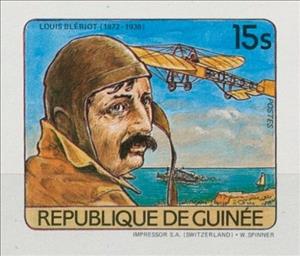Stamp: Louis Blériot (1872-1936) (Guinea 1984)
Louis Blériot (1872-1936) (Guinea 1984)
20 August (Guinea ) within release Personalities (Series II) (1984) goes into circulation Stamp Louis Blériot (1872-1936) face value 15 Guinean syli
| Stamp Louis Blériot (1872-1936) in catalogues | |
|---|---|
| Michel: | Mi: GN 991B |
Stamp is square format.
Also in the issue Personalities (Series II) (1984):
- Stamp - Abraham Lincoln (1809-1865) face value 5;
- Stamp - Abraham Lincoln (1809-1865) face value 5;
- Souvenir Sheet - Abraham Lincoln (1809-1865) face value 5;
- Souvenir Sheet - Abraham Lincoln (1809-1865) face value 5;
- Stamp - Anatoly Karpov (born 1951) face value 30;
- Souvenir Sheet - Anatoly Karpov (born 1951) face value 30;
- Souvenir Sheet - Anatoly Karpov (born 1951) face value 30;
- Stamp - Auguste Piccard (1884-1962) face value 25;
- Stamp - Auguste Piccard (1884-1962) face value 25;
- Souvenir Sheet - Auguste Piccard (1884-1962) face value 25;
- Souvenir Sheet - Auguste Piccard (1884-1962) face value 25;
- Stamp - Gottlieb Daimler (1834-1900) face value 10;
- Stamp - Gottlieb Daimler (1834-1900) face value 10;
- Souvenir Sheet - Gottlieb Daimler (1834-1900) face value 10;
- Souvenir Sheet - Gottlieb Daimler (1834-1900) face value 10;
- Stamp - Jean-Henri Dunant (1828-1910) face value 7;
- Stamp - Jean-Henri Dunant (1828-1910) face value 7;
- Souvenir Sheet - Jean-Henri Dunant (1828-1910) face value 7;
- Souvenir Sheet - Jean-Henri Dunant (1828-1910) face value 7;
- Stamp - Louis Blériot (1872-1936) face value 15;
- Stamp - Louis Blériot (1872-1936) face value 15;
- Souvenir Sheet - Louis Blériot (1872-1936) face value 15;
- Souvenir Sheet - Louis Blériot (1872-1936) face value 15;
- Stamp - Paul Percy Harris (1868-1947) face value 100;
- Stamp - Paul Percy Harris (1868-1947) face value 100;
- Souvenir Sheet - Paul Percy Harris (1868-1947) face value 100;
- Souvenir Sheet - Paul Percy Harris (1868-1947) face value 100;
- Souvenir Sheet - Paul Percy Harris (1868-1947) face value 100;
- Souvenir Sheet - Paul Percy Harris (1868-1947) face value 100;
- Stamp - Paul Percy Harris (1868-1947) face value 20;
- Stamp - Paul Percy Harris (1868-1947) face value 20;
- Souvenir Sheet - Paul Percy Harris (1868-1947) face value 20;
- Souvenir Sheet - Paul Percy Harris (1868-1947) face value 20;
- Mini Sheet - Personalities (Series II) face value 82;
- Mini Sheet - Personalities (Series II) face value 82;
Stamp Louis Blériot (1872-1936) it reflects the thematic directions:
An aircraft (pl. aircraft) is a vehicle that is able to fly by gaining support from the air. It counters the force of gravity by using either static lift or the dynamic lift of an airfoil, or, in a few cases, direct downward thrust from its engines. Common examples of aircraft include airplanes, rotorcraft (including helicopters), airships (including blimps), gliders, paramotors, and hot air balloons.Part 1 (Definitions and Abbreviations) of Subchapter A of Chapter I of Title 14 of the U. S. Code of Federal Regulations states that aircraft "means a device that is used or intended to be used for flight in the air."
Aviation is the practical aspect or art of aeronautics, being the design, development, production, operation and use of aircraft, especially heavier than air aircraft. The word aviation was coined by French writer and former naval officer Gabriel La Landelle in 1863, from the verb avier (synonymous flying), itself derived from the Latin word avis ("bird") and the suffix -ation.
Engineers, as practitioners of engineering, are professionals who invent, design, analyze, build and test machines, complex systems, structures, gadgets and materials to fulfill functional objectives and requirements while considering the limitations imposed by practicality, regulation, safety and cost.The word engineer (Latin ingeniator, the origin of the Ir. in the title of engineer in countries like Belgium and The Netherlands) is derived from the Latin words ingeniare ("to contrive, devise") and ingenium ("cleverness"). The foundational qualifications of a licensed professional engineer typically include a four-year bachelor's degree in an engineering discipline, or in some jurisdictions, a master's degree in an engineering discipline plus four to six years of peer-reviewed professional practice (culminating in a project report or thesis) and passage of engineering board examinations.
Famous People refers to the fame and public attention accorded by the mass media to individuals or groups or, occasionally, animals, but is usually applied to the persons or groups of people (celebrity couples, families, etc.) themselves who receive such a status of fame and attention. Celebrity status is often associated with wealth (commonly referred to as fame and fortune), while fame often provides opportunities to make money.
An invention is a unique or novel device, method, composition, idea, or process. An invention may be an improvement upon a machine, product, or process for increasing efficiency or lowering cost. It may also be an entirely new concept. If an idea is unique enough either as a stand-alone invention or as a significant improvement over the work of others, it can be patented. A patent, if granted, gives the inventor a proprietary interest in the patent over a specific period of time, which can be licensed for financial gain.




